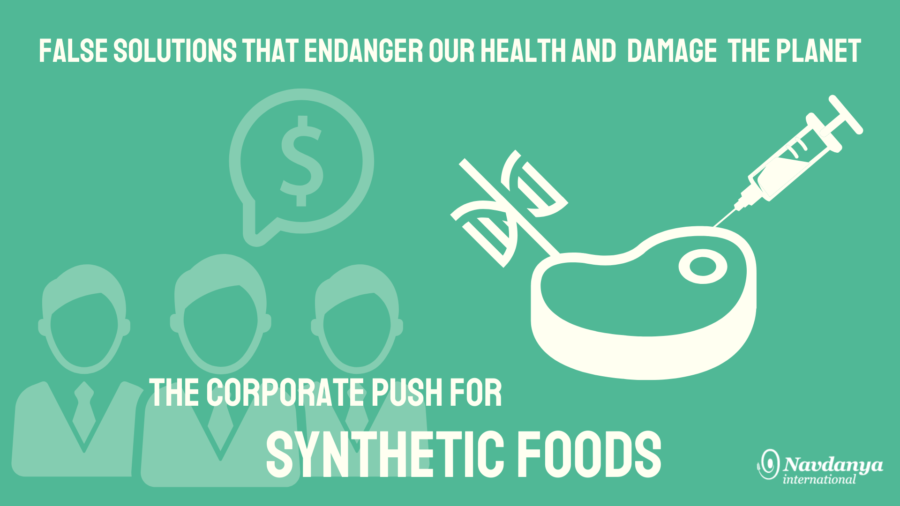
Read the Foreword: Artificial Food is Detrimental to Ecological Transition, by Dr Vandana Shiva
Read the article: An Impossible Menu: Fake Food is taking over our tables
Download Report pdf
Written by Navdanya International
The corporate push for synthetic foods
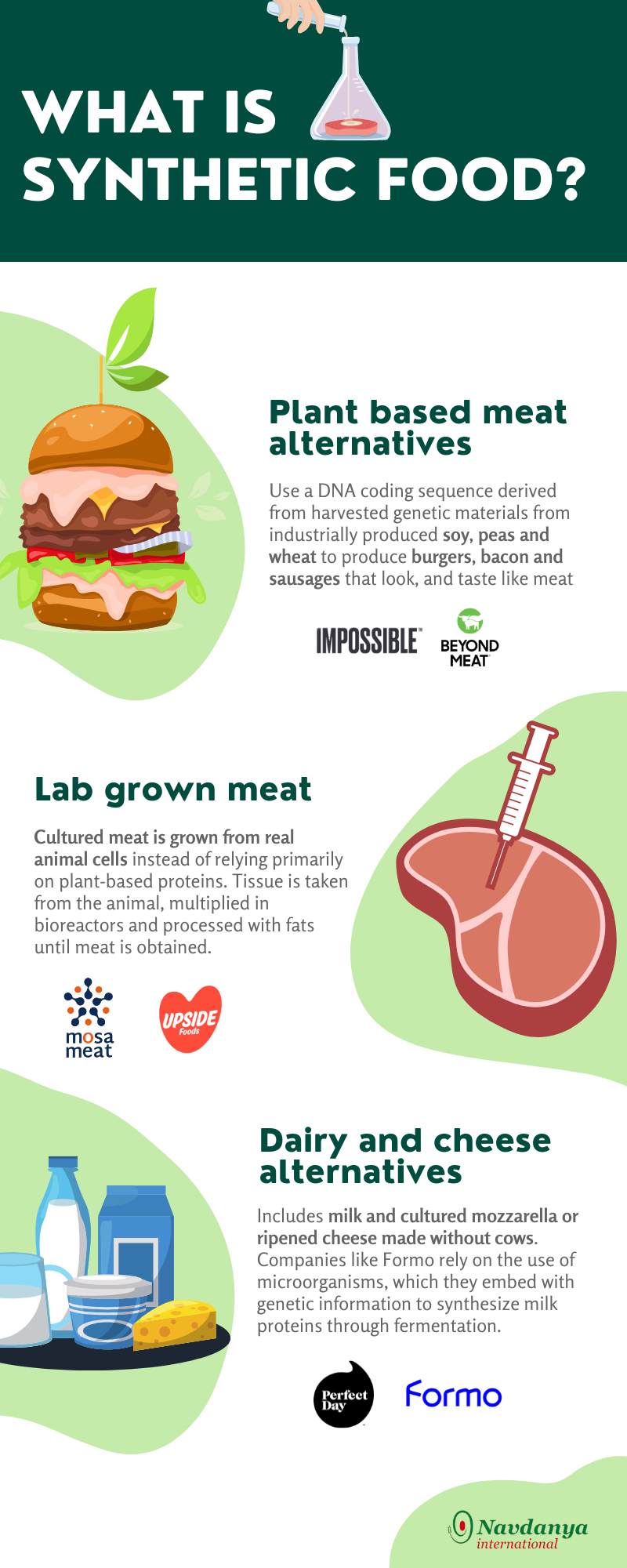 Fully artificial food is an increasingly popular trend focused on developing a new line of synthetically produced, ultra-processed food products by using recent advances in synthetic biology, artificial intelligence, and biotechnology. These new products seek to imitate and replace animal products, food additives, and expensive, rare, or socially conflictive ingredients (such as palm oil). Biotech companies and agribusiness giants are seeing the opportunity to move into this promising market of “green” consumption and hence these products are marketed to a new generation of environmentally conscious consumers who are growing critical of the grim realities of industrial food production. As a result, meatless burgers and sausages, as well as imitations of cheese, dairy products, seafood, and others, have begun to flood the market, being found anywhere from fast food chains to local grocery stores.
Fully artificial food is an increasingly popular trend focused on developing a new line of synthetically produced, ultra-processed food products by using recent advances in synthetic biology, artificial intelligence, and biotechnology. These new products seek to imitate and replace animal products, food additives, and expensive, rare, or socially conflictive ingredients (such as palm oil). Biotech companies and agribusiness giants are seeing the opportunity to move into this promising market of “green” consumption and hence these products are marketed to a new generation of environmentally conscious consumers who are growing critical of the grim realities of industrial food production. As a result, meatless burgers and sausages, as well as imitations of cheese, dairy products, seafood, and others, have begun to flood the market, being found anywhere from fast food chains to local grocery stores.
Although these products market themselves as ‘eco-friendly’, ‘healthy’, and ‘sustainable’, they are no such thing as they do little to truly address the root problems of industrial agriculture and its environmental, and health consequences. Consequences that can be largely blamed on the same circle of businessmen who today finance the development of this biotech industry. These products instead represent the next generation of ultra-processed junk foods that work to further entrench industrial agriculture models due to their direct dependence on globalized commodity chains, agrochemicals, GMOs, monocultures, and even conventional animal production. In other words, synthetic foods are quickly becoming a next means to consolidate even more power and profit into the hands of a few food giants without facing the implications of ecological devastation, worsening human health, and exacerbated climate change.
One of the key differences between conventional junk food products and these new synthetic foods is the use of new technological innovations such as synthetic biology and genetic engineering. Synthetic biology is a new type of biotechnology which is now creating entirely new organisms and microorganisms through the genetic modification or engineering of an organism’s internal genetic parts to reconfigure them in new ways. By implanting pieces of other organisms’ DNA into microorganisms, or reconfiguring internal genetic information, these new technologies trigger microorganisms, cells, or other forms of genetic material to ‘ferment’ and reproduce in order to trigger them to create new, completely synthetic ingredients. The use of the word ‘fermentation’ in synthetic biology hence creates a false analogy between traditional forms of natural microbial fermentation and these new, completely artificial biotechnologies.
These new technologies are now being used by companies such as Beyond Meat, Motif Foodworks, Ginkgo Bioworks (custom-built microbes), BioMilq (lab-grown breast milk), Nature’s Fynd (fungi-grown meat and dairy alternatives), Eat Just (egg substitutes made from plant proteins), Perfect Day Food (lab-grown dairy products) or NotCo.
Companies such as Beyond Meat and Impossible Foods use a DNA coding sequence derived from soybeans or peas to create a product that looks and tastes like real meat. Imitations of cheese and dairy products are also starting to pop up. For instance, companies like Formo are using synthetic biology to synthesise milk proteins through fermentation for mozzarella and ricotta cheeses without cows.
Filler ingredients for these products also still rely heavily on the extensive processing of conventionally cultivated and mostly GMO crops. For instance, the Impossible Burger is made almost entirely from industrially produced wheat, maize, soya, coconut and potato, in addition to additional bioengineered ingredients. Proteins, carbohydrates from these conventional crops are chemically extracted, cooked and then extruded through machines that blend and shape them into strands resembling short muscle fibers, allowing manufacturers to convincingly imitate a range of processed meat products[1].
Cell-Cultured Synthetic Meat and Dairy
Lab-grown or cultured meat and dairy products are now also being marketed as yet another alternative to animal products, with many companies investing in cell-culturing or ‘fermentation’ of foods made from real animal cells. In the case of cell-based meat, tissue is taken from a living cow and combined with extracted stem cells to grow into muscle fibers in the lab. Once enough (over 20,000) have been obtained from this process they are colored, minced, mixed with fats, and shaped into burgers.
For instance, Upside Foods (previously known as Memphis Meats) produces meat through this method, by using self-reproducing animal cells. The rationale is that such an approach would eliminate the need to breed and slaughter a huge amount of animals, thus ironing out many ethical and ecological concerns along the supply chain. While lab-grown meat is not yet available to the public, companies like Upside Foods are heavily investing in research and development in order to make their products economically affordable over the long term to compete with commercial meat options. The Canadian company Better Milk, for instance, is also investing heavily in the production of cow’s milk using bovine mammary cells.
Yet, whether upscaling lab-grown food will one day be economically viable remains very doubtful. An article from the Counter reflects on the limits of the transformative potential of this emerging technology, with particular attention to the many obstacles faced by cultured meat companies. Through a rigorous review of scientific data, the article demonstrates that cultivated meat gives rise to a lot of inefficiencies and limitations in scalability, embodied by the need for intensive and sophisticated machinery, structural limitations on cell metabolisms and immunity to foreign contaminants, and a series of complex processes that all place a strict limit on the expansion of production. These factors contribute to a lack of cost competitiveness in comparison with the conventional meat products they wish to replace, as cultured meat production would amount to far less than conventional slaughterhouses. Especially when cell-culturing facilities at the scale needed have previously never been made viable.
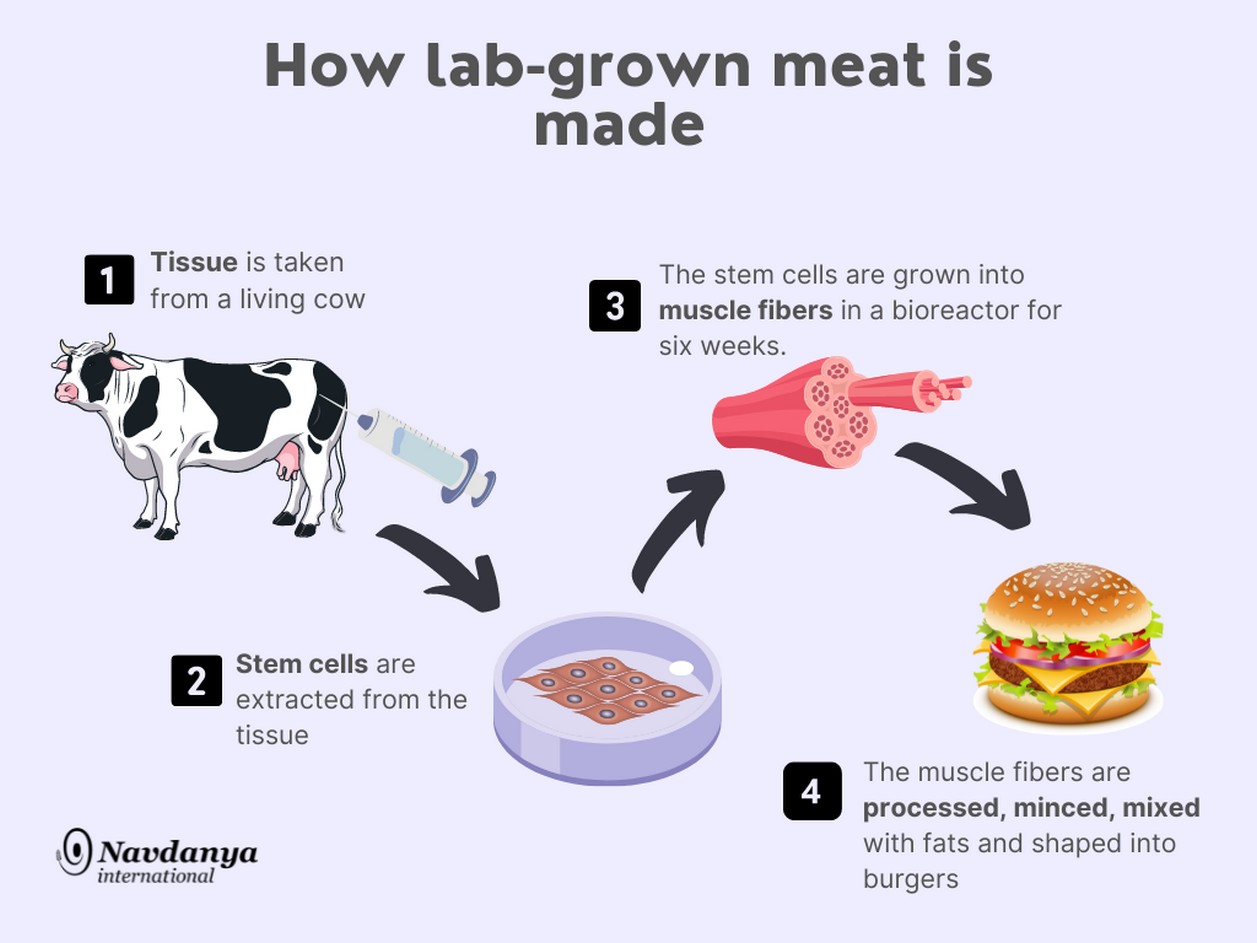
Who is behind the surge of fake food and who benefits?
Over the last couple of years, and following the relentless emergence of new startups, the market for synthetic and plant-based alternatives has been rapidly expanding, with financial backing skyrocketing in 2020. The Good Food Institute, a lobby advocate group for the adoption of animal product alternatives, reports that in the United States, the plant-based market has already grown from 4.9 billion in 2018 to 7 billion in 2020, which represents an overall increase of 43% in dollar sales over the last two years. Similarly, the plant-based meat market is also booming, having reached a value of 1.4 billion and registered a growth of 72% by 2020. Beyond Meat has been one of the “hottest” stocks in 2019. The plant-based meat company’s shares grew a whooping 859% during its first three months.
The synthetic biology industry is also right behind. It has reached a value of $12 billion in the last decade and is expected to double by 2025, and to reach $85 billion in 2030. Companies specializing in this field have also grown six-fold in the last ten years.
Clearly it is agribusiness that stands to profit from this lucrative and quickly expanding market. Therefore, It should not come as a surprise that a lot of meat industry giants like Tyson foods, JBS, Cargill, Nestlé, and Maple Leaf Foods are investing in this blossoming market. Moreover, high profile big tech investors such as Microsoft founder Bill Gates and Amazon founder Jeff Bezos have also joined in by providing substantial financial backup to startups and biotechnology companies pursuing innovations in the sector. In fact, Bill Gates alone has already invested 50 million dollars in Impossible Foods and actively finances Beyond Meat, Ginkgo Bioworks, BioMilq, Motif Foodworks, C16 Biosciences, and Memphis Meats (now Upside Foods) through his Breakthrough Energy Ventures investment fund.
Other prominent start-ups funded by this billionaire investment include- Eat Just (egg substitutes made from plant proteins), Perfect Day Food (lab-grown dairy products), and NotCo (plant-based animal products made through AI), to name a few.
Given the widespread success of the plant-based industry, it is not surprising that big plant-breeding companies like Bayer also see a great opportunity for investment and expansion in this market. As put by Bob Reiter, Bayer’s head of research and development at the company’s crop science division, in reference to plant based-meat companies: “They are sourcing different types of crops and that could also create opportunity for us, being a company that is a plant-breeding company”.
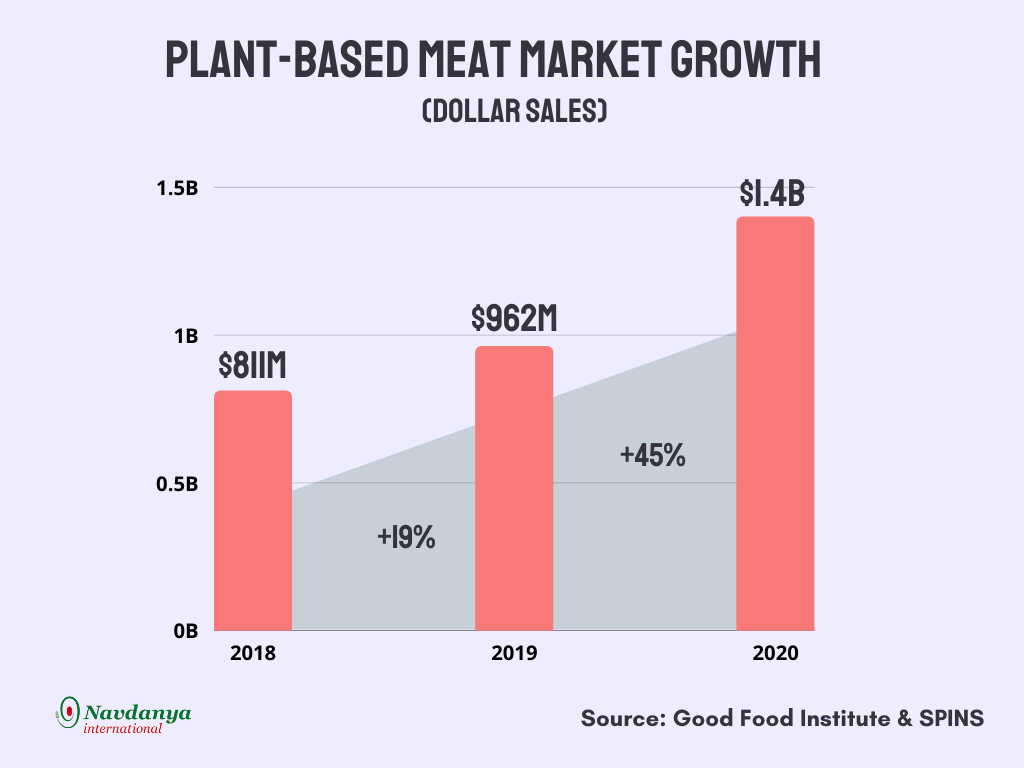
An ecological choice or a wolf in sheep’s clothing?
Many studies are questioning the alleged sustainability of this industry, which now comprises a constellation of new ‘green-conscious’ start-ups. It is not surprising that the tremendous rise of synthetic foods is happening at a time when ethical concerns linked to the meat and dairy industry are increasingly under the spotlight. As the industrial agrifood industry is threatened by consumer apathy, big companies that stand to lose significant profits are trying to tap into a new market of environmentally aware consumers looking for alternatives. Hence, the promotion of these synthetic foods is nothing more than a clever way to reorient profits back to the same old companies by re-purposing the destructive technologies of the Green Revolution combined with new biotechnologies as a well-disguised ‘sustainable alternative’.
This reinforcement of the industrial agriculture production model becomes evident when one looks at the ingredients that make up these synthetic foods. Primarily made up of conventionally grown peas, potatoes, soya, coconut, and maize, these products rely on heavy processing, monocultures, agrochemicals, GMOs, deforestation and a contaminating global-supply chain.
Yet, companies remain adamant in their claims that their plant-based meats require less water, less land, and produce less greenhouse gases than their counterparts, as well as simultaneously ironing out animal welfare concerns. In so doing, they deliberately sidestep the impacts of the toxic industrial supply chain their products depend on.
In addition, lab-grown counterparts also require massive bioreactors, and the use of sterile single-use plastic equipment. To come close to matching current meat consumption, for example, production facilities would need to number in the tens of millions, increasing problematic plastic consumption and increasing energy requirements, all while still relying on globalized industrial agriculture models and supply chains.
Most significantly, to run, these bioreactors require large amounts of nutrients for cells to grow and reproduce. Given the limited production of individual amino acid formulations suited for cell culture globally, one hope is to use soy to derive the full amino acid profile necessary for cell growth. This would work to only further entrench the already destructive cultivation of soy.
Gruesomely and ironically, other parts of the nutrient broth used to culture cells also directly derive from current industrial animal production, as some of them are made using fetal cow’s blood obtained from conventionally slaughtered pregnant cows. Stem cells necessary for cell reproduction during the cell culturing process also come from fetal cows. Without the mass abundance of slaughtered fetal cows, can cell-cultured meat scale up? And so, can lab-grown meat be considered to solve the problem of animal welfare and environmental degradation if it is completely dependent on ingredients that derive from industrial beef production? This gruesome reality says otherwise.
Meat analogs and cell-based meats are also much more carbon intensive than we are led to believe. A recent study has shown that the fossil fuel energy required for the production of lab meat is not sustainable and could by far surpass the output of livestock like pigs and poultry.
Vast amounts of energy are required for the production of synthetic foods. These include several energy intensive steps such as the operation of the bioreactors, temperature controls, aeration, and mixing processes. Thus, on the basis of these indicators, the sector is in no position to claim that synthetic meat production is inherently more sustainable than traditional production systems. Studies like these further point to how upscaling synthetic meat production is not the way towards a carbon free society, especially when we consider the scaling needed to match current consumption levels of the products this industry is trying to replace.
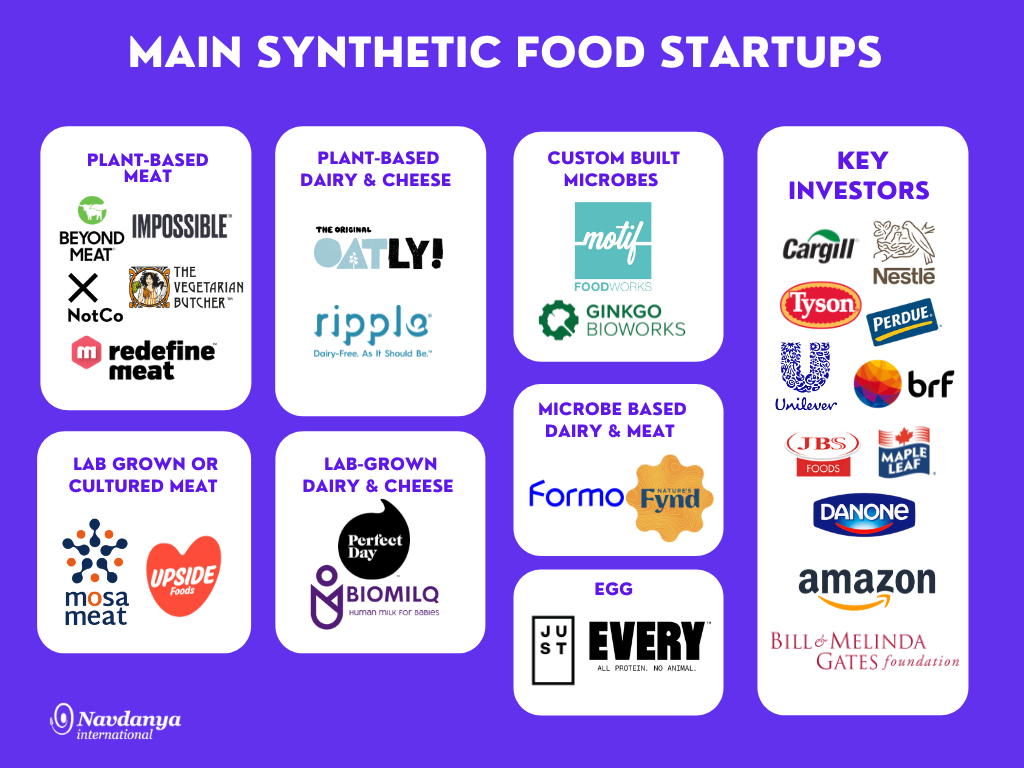
Are plant-based foods healthier? Not if they are ultra-processed
It is now widely known how industrial processing can make food less nutritious and thus harmful to human health, and according to a recent report, the latest generation of junk synthetic foods is no exception. In order to make their products, chemically extracted protein isolates from commodity crops such as soy, peas and potatoes are used and mixed in with added flavorings, food additives, and now, perhaps most dangerously, genetically engineered artificial ingredients to try to approximate the taste and texture of real animal products. As a result, these ultra-processed foods typically contain high levels of sodium, fats and artificial food enhancers in order to be palatable, placing them under the same categories as junk foods.
Moreover, ultra processed foods are made from refined ingredients which means that they lack many of the nutrients found in traditional animal products such as zinc, iron and vitamin B-12. These nutrients and fortifiers thus need to be added as separate ingredients in synthetic meat, but cannot be absorbed as effectively as they would from whole foods, and can cause harmful interference with other nutrients. As a result our bodies may derive less health benefits from them and therefore they should not be part of a nutritious and environmentally friendly diet.
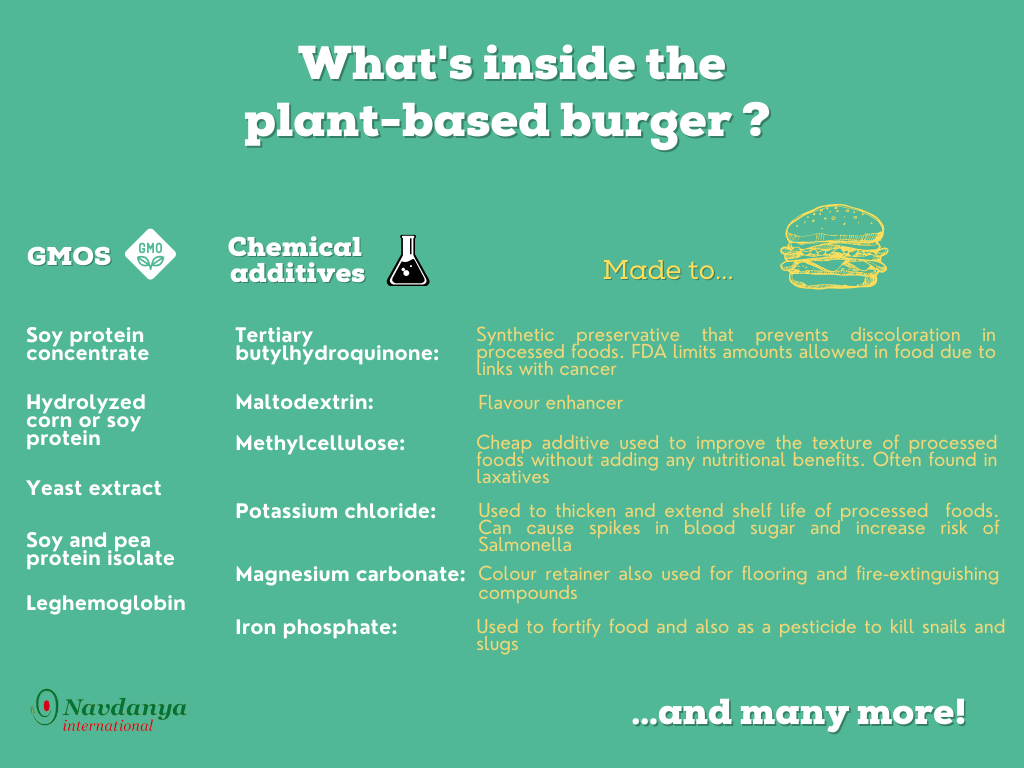
The safety of new ingredients and additives used is also a cause for concern. For example, to make the Impossible Burger appear to “bleed” like real meat, a synthetically produced “heme” molecule is added which comes from soy leghemoglobin, a colorant produced in genetically engineered yeast. The adoption of this patented new ingredient has been nothing short of controversial. According to the Center for Food Safety, the FDA did not conduct adequate long-term testing before approving the additive in 2019, and after a short-term rat trial, several potential adverse effects were detected like changes in weight gain, changes in the blood that can indicate inflammation or kidney disease, disruptions in the reproductive cycle and possible signs of anemia. Despite the lack of evidence that the additive is safe, Impossible Foods’ products containing genetically engineered heme are now being sold in supermarkets across the United States, exemplifying the lack of testing and regulation for these new products and technologies.
Highly toxic glyphosate has also been found in the Impossible Burger with amounts being more than enough to have a variety of negative health effects.This is also not mentioning synergistic effects this might have with the variety of toxic food additives these companies mix in to mask flavors, and the unknown health effects of synbio-produced additives.
Profitable Patents
Synthetic foods symbolize yet another profit-making machine used by billionaires and big corporations to capitalize on proprietary technology and increase their control over the world’s resources. This is reflected in companies’ ceaseless pursuit of patents for anything from novel processes of synthetic biology, genetically engineered ingredients like soy leghemoglobin, protein texturizing processing and even the patenting of genetic materials used as raw materials. As was shown in the Navdanya International Gates to a Global Empire report, 27 patents have been assigned to Impossible Foods, with over 100 additional patents pending for other fake meat proxies, from chicken to fish.
The patenting logic that underlies the synthetic food movement, sees animals and nature as disposable elements that can simply be replaced by more efficient technologies such as lab-engineered products. This dangerous way of thinking reduces animals to mere inputs in a production system, thus completely ignoring our relationship with nature and further creating a rift separating humans from nature and food from life.
Handing over control of our food to a handful of multinational companies does not only make us increasingly dependent on them, it can also have detrimental consequences on local food systems and erode the food sovereignty of organic farmers.
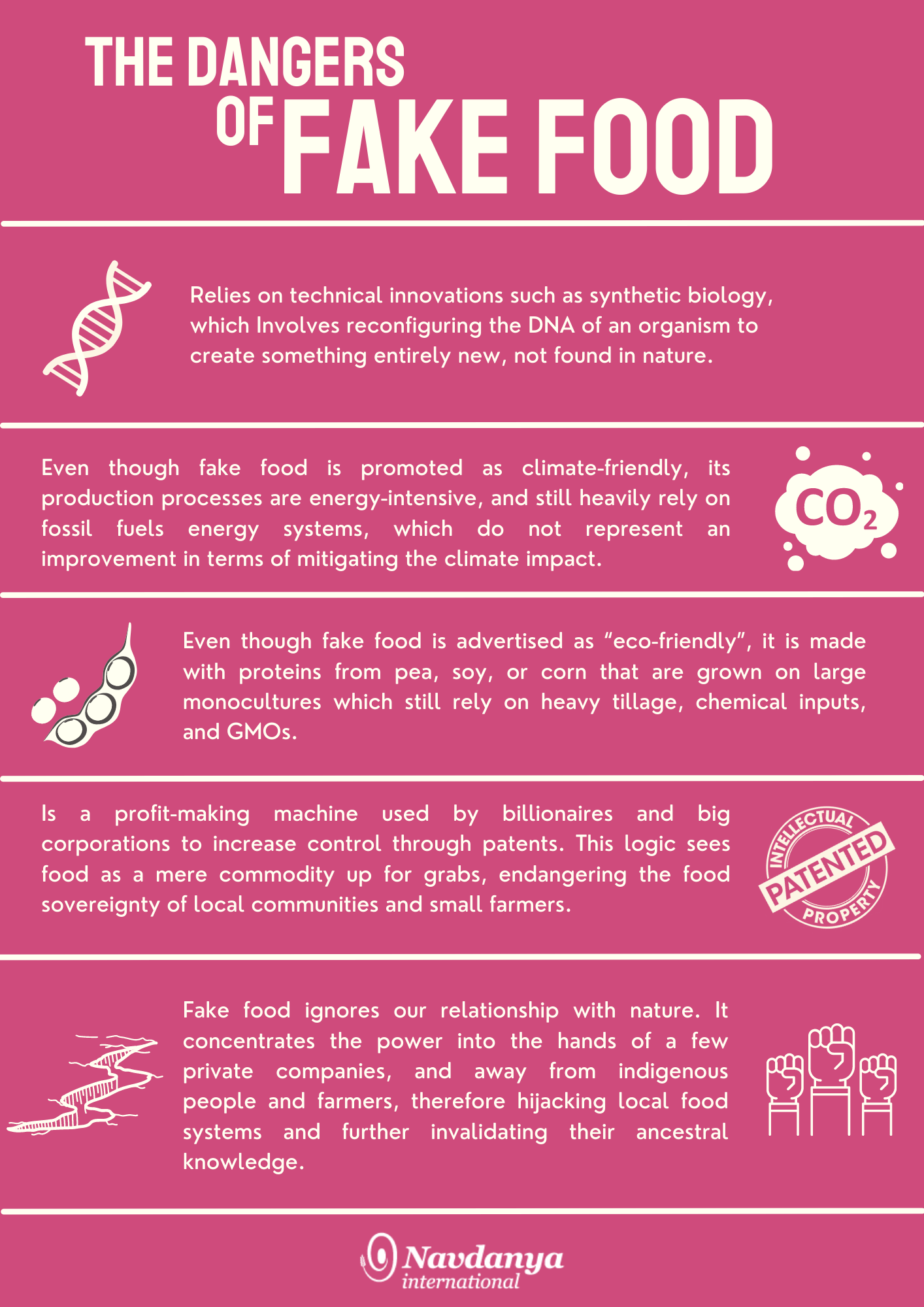
International appetites for ultra-processed foods
In addition to conquering our plates and diets, synthetic food is slowly starting to take over multi-level governance arenas. This was most apparent in last years’ UN Food Systems Summit, as well as the COP26. Both serving as forums to showcase the true intentions of agribusiness and food giants– namely, to keep the system unchanged. As anticipated, both summits marked yet another failed attempt at addressing power imbalances in the food system, with sustainable farming practices like agroecology only playing a marginal role. The summits were thus met with resounding backlash from environmental associations and civil society organizations.
Reflected in the themes and proposals of both international events was the willingness to keep business as usual and continuing to rely on the failed industrial agricultural model by allowing big actors to dictate terms. For instance, during both the UNFSS and the COP26 there was explicit promotion of artificial and ultra processed plant-based foods, under the language of achieving ‘protein diversification’ and ‘sustainable diets’. During the COP26 the “Plant-Based Treaty” was promoted and backed by all the above-mentioned actors, and during the UNFSS under similar initiatives were promoted in Action Track 2 led by Nestlé, Danone and the controversial EAT organization.
Which future for our food?
There are many dangers associated with the above discourses entering the global governance arena. Especially if they mean a further consolidation of policies that shift attention and resources away from organic farmers and local markets toward a handful of biotech companies. Despite food advocates’ claims that the proliferation of synthetic alternatives to animal products can resolve animal welfare concerns and solve many of our ongoing crises, the ‘plant-based’ label means very little if it is based on industrial models, monocultures, GMOs, pesticides, and other destructive agricultural practices that lead to biodiversity loss, ecological degradation and worsening health.
Synthetic food is thus nothing more than a fake solution that aims to replace products without challenging the power structures that underlie the corporate agricultural model. Moreover, it completely ignores the solutions offered by the growing regenerative agriculture movement and completely disregards the role of small producers and food communities in shaping our food systems. This mindset explains why we will soon see Beyond Meat burgers in McDonald’s plant-based menus when we should instead focus on the necessity for real regenerative agriculture and systemic change to protect nature and people’s health.
What We Need is Real Food
In the end, these artificial, synthetic foods dismantle our connection with nature and in doing so, they completely disregard the role of natural processes and the laws of ecology that are at the heart of real food production. By promoting the illusion that we live outside of nature’s ecological processes, this new technology will only serve to increase corporate control over food and health, accelerate the collapse of local food economies and further destroy food democracy. The real solution to the environmental, and health crises should be based on an active rejuvenation and regeneration of the planet by working with ecological processes through agroecological and regenerative farming practices.
Contrary to the claims of the agro-industry and food tech companies, food cannot be reduced to a commodity to be put together mechanically and artificially in labs and factories. Food is the currency of life and it holds the contribution of all beings involved at all stages of production. Claiming otherwise would be a negation of local indigenous knowledge and pastoralist cultures that have evolved alongside diverse ecosystems over the centuries to regenerate biodiversity and contribute to the diversity of farming systems.
Animals, humans, and nature have always lived in interconnected, symbiotic relationships which in turn regenerate all systems that support life. This synergy is vital to the renewal of soil fertility, the creation of habitat for biodiversity, and the rejuvenation of Earth’s water, carbon, and nutrient cycles. While concerns about the meat industry are legitimate, animals integrated into a biodiverse, agroecological system can provide a viable alternative to an agricultural system based on exploitation and environmental destruction. Animals have always held a central function in agroecological systems, since when they feed on grass, pests, and weeds, they, in turn, fertilize the soil, improve biodiversity at all levels, and help sequester carbon back into the earth. Animals in symbiotic and balanced relationships with plants, soils, and humans have also formed central parts of cultural and agricultural reproduction for millennia, contributing to much more than just meat production.
On the other hand, the industrial raising of animals through CAFOs (Concentrated Animal Farm Operations) who are force-fed industrially grown grains and soy, contribute to the expansion of GHG-emitting industrial agriculture, causing a greater release of methane and the pollution of air and water sources. It is important to emphasize how these two systems are not at all alike, as meat consumption per se is not the problem, rather it is the industrial meat production model hand in hand with the industrial agriculture model that is responsible for the majority of GHG emissions, animal suffering, and environmental degradation. Therefore, the real solution does not lie in creating substitutes for food, it lies in understanding the needs of the ecosystems we are embedded in and healing our connection with nature.
Real food made through real farming is the direct result of a process of care for the land, animals, and fellow humans that celebrates the connection between food and life. It protects the life of all beings on Earth while also nourishing our health and wellbeing. Artificial food is a direct manifestation of years of food imperialism and colonization that has denied our diverse food knowledge, food cultures, and disregarded the biodiversity of the earth and its ecosystems.
Hope does not lie in pursuing technological innovations such as lab-grown synthetic foods that see nature as a dead and unimprovable technology, but in participating and rejuvenating the earth’s natural processes. The question of what we eat, how we grow the food we eat, and how we distribute it has become a survival imperative for the human species and all beings that make up the web of life. When we farm with real knowledge of how to care for the Earth and her biodiversity, when we eat real food which nourishes the biodiversity of the Earth, our cultures, and our gut microbiome, we are then participating in real and living economies that regenerate the well-being of all. All over the world, small farmers and gardeners are already preserving and developing their soils and their seeds through the practice of agroecology. They are feeding their communities with healthy and nutritious food while also rejuvenating the planet.
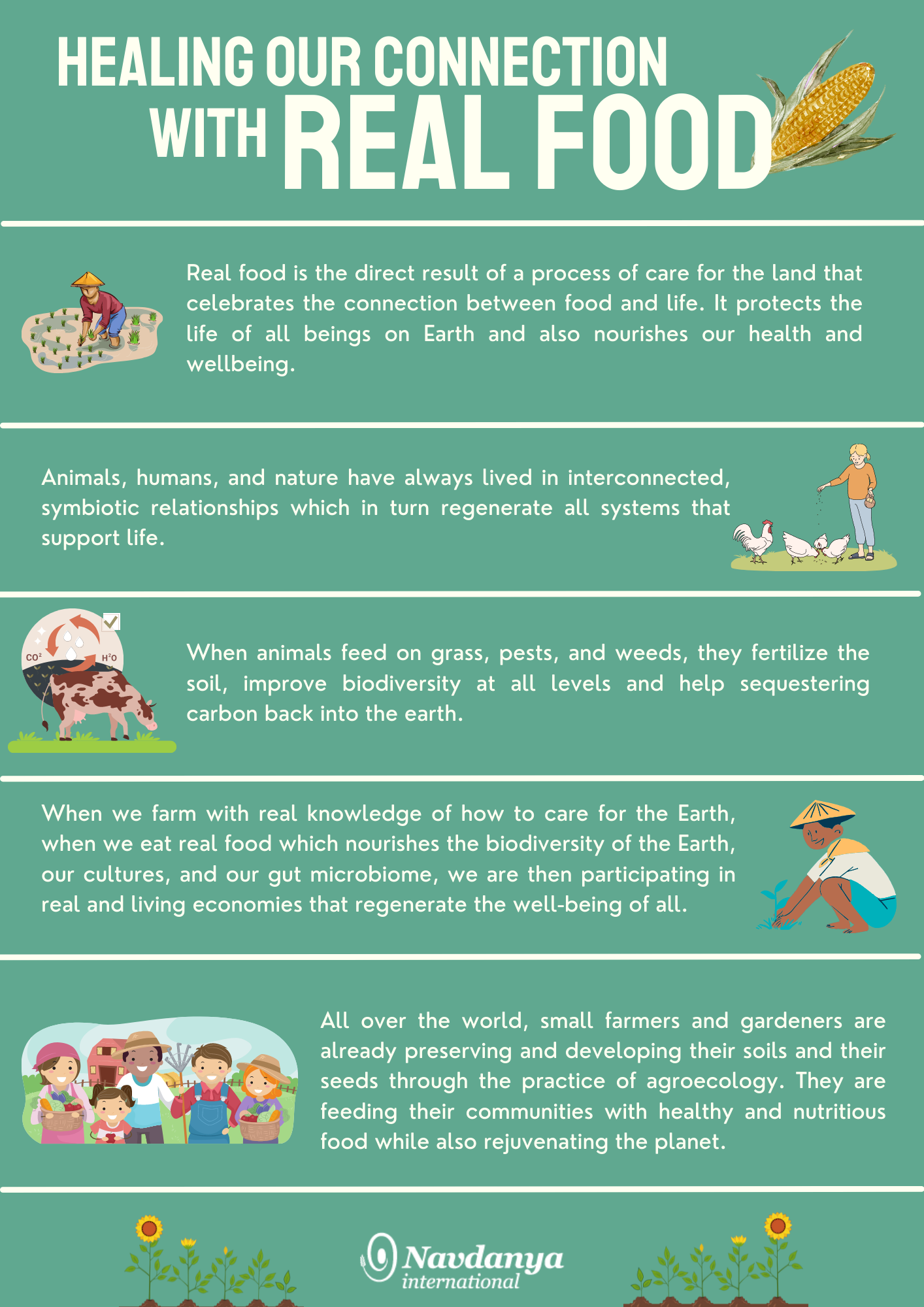
[1] Kyriakopoulou, Konstantina, et al. “Plant-Based Meat Analogues.” Sustainable Meat Production and Processing, edited by Charis Galanakis, Academic Press, 2019, pp. 103–126. Science Direct. doi.org/10.1016/B978-0-12-814874-7.00006-7.
© Navdanya International
March 2022
